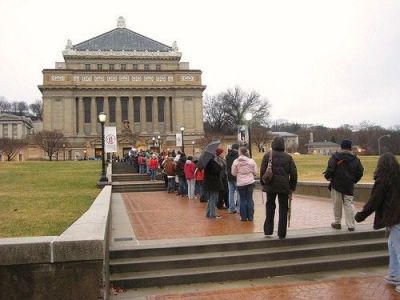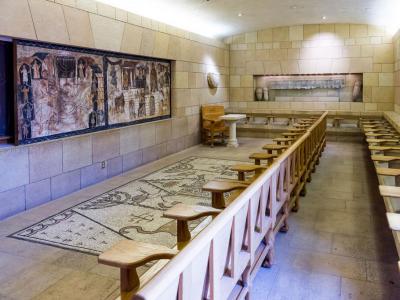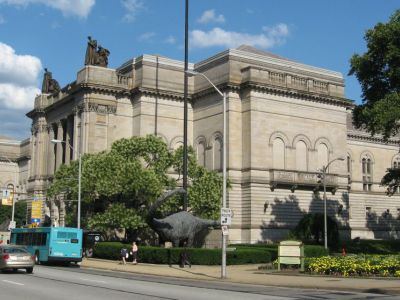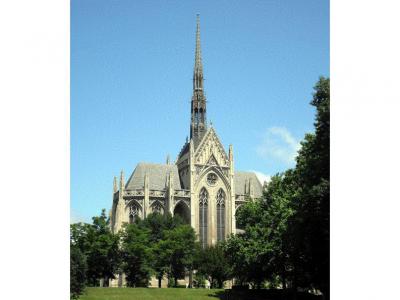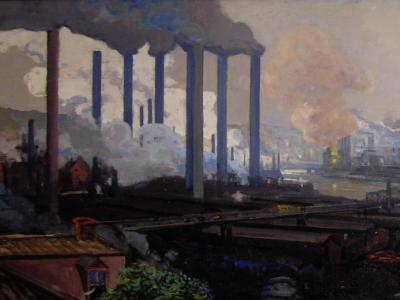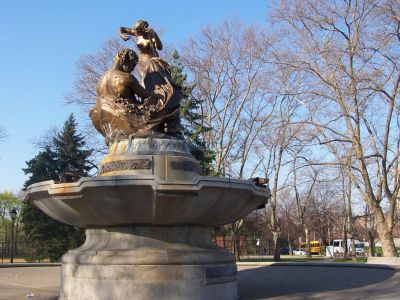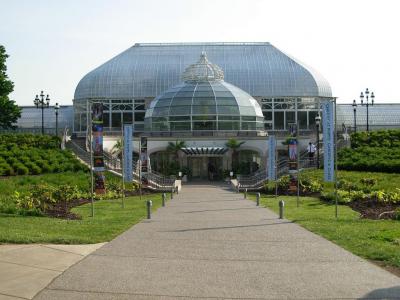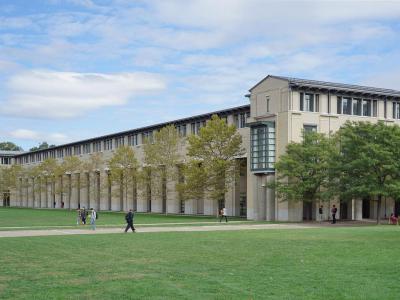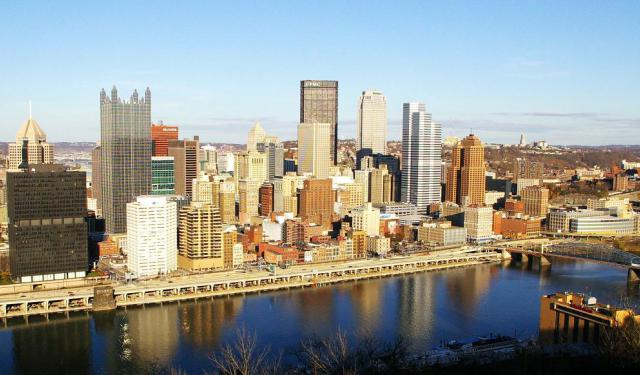
Oakland District Walking Tour (Self Guided), Pittsburgh
Welcome to Oakland, an academic and cultural center of Pittsburgh! Representing a harmonious blend of intellectual prowess, cultural marvels, and natural splendor, this captivating neighborhood brims with attractions to overlook which would be a terrible miss!
As a manifestation of the transformative power of knowledge and creativity, Oakland, in large part, owes its status to the 19th-century Scottish-American industrialist and philanthropist Andrew Carnegie who once said: "Pittsburgh entered the core of my heart when I was a boy and cannot be torn out."
In the heart of this intellectual enclave, the illustrious Carnegie Museums hold court, gracing the landscape with their extensive collections. Immerse yourself in the Carnegie Museum of Natural History, where prehistoric relics and mesmerizing minerals transport you to ancient epochs. Meanwhile, the Carnegie Museum of Art beckons, unveiling a showcase of artistic expressions spanning eras and genres, from classical to contemporary, igniting the imagination.
Oakland's verdant jewel, Schenley Park is an oasis of tranquility amid the bustling city. The enchanting Phipps Conservatory and Botanical Gardens inside the park delight visitors with the kaleidoscope of flora. Here, botanical artistry intertwines with environmental education, fostering a deeper connection to the world around us.
In the hallowed halls of academia, Oakland boasts the prestigious University of Pittsburgh and Carnegie Mellon University, veritable pillars of intellectual enlightenment. Wandering through the sprawling main campus of the University of Pittsburgh, make sure to ascend the storied steps of the iconic Cathedral of Learning, an emblem of educational ambition, and traverse the international Nationality Rooms.
A testament to valor and sacrifice, Soldiers & Sailors Memorial Museum stands as a hallowed tribute to the brave men and women who served their country. The museum honors veterans and features exhibits highlighting the military history of the United States.
In Oakland, Pittsburgh, the pursuit of knowledge and artistic expression coalesce, leaving lasting memories and a profound appreciation for the wonders that surround us. No trip to the city is complete without a visit to this vibrant area. In addition to several universities and world-class museums, there's also an abundance of shopping, dining, and recreational facilities for your enjoyment. Feel free to take this self-guided tour and see for yourself!
As a manifestation of the transformative power of knowledge and creativity, Oakland, in large part, owes its status to the 19th-century Scottish-American industrialist and philanthropist Andrew Carnegie who once said: "Pittsburgh entered the core of my heart when I was a boy and cannot be torn out."
In the heart of this intellectual enclave, the illustrious Carnegie Museums hold court, gracing the landscape with their extensive collections. Immerse yourself in the Carnegie Museum of Natural History, where prehistoric relics and mesmerizing minerals transport you to ancient epochs. Meanwhile, the Carnegie Museum of Art beckons, unveiling a showcase of artistic expressions spanning eras and genres, from classical to contemporary, igniting the imagination.
Oakland's verdant jewel, Schenley Park is an oasis of tranquility amid the bustling city. The enchanting Phipps Conservatory and Botanical Gardens inside the park delight visitors with the kaleidoscope of flora. Here, botanical artistry intertwines with environmental education, fostering a deeper connection to the world around us.
In the hallowed halls of academia, Oakland boasts the prestigious University of Pittsburgh and Carnegie Mellon University, veritable pillars of intellectual enlightenment. Wandering through the sprawling main campus of the University of Pittsburgh, make sure to ascend the storied steps of the iconic Cathedral of Learning, an emblem of educational ambition, and traverse the international Nationality Rooms.
A testament to valor and sacrifice, Soldiers & Sailors Memorial Museum stands as a hallowed tribute to the brave men and women who served their country. The museum honors veterans and features exhibits highlighting the military history of the United States.
In Oakland, Pittsburgh, the pursuit of knowledge and artistic expression coalesce, leaving lasting memories and a profound appreciation for the wonders that surround us. No trip to the city is complete without a visit to this vibrant area. In addition to several universities and world-class museums, there's also an abundance of shopping, dining, and recreational facilities for your enjoyment. Feel free to take this self-guided tour and see for yourself!
How it works: Download the app "GPSmyCity: Walks in 1K+ Cities" from Apple App Store or Google Play Store to your mobile phone or tablet. The app turns your mobile device into a personal tour guide and its built-in GPS navigation functions guide you from one tour stop to next. The app works offline, so no data plan is needed when traveling abroad.
Oakland District Walking Tour Map
Guide Name: Oakland District Walking Tour
Guide Location: USA » Pittsburgh (See other walking tours in Pittsburgh)
Guide Type: Self-guided Walking Tour (Sightseeing)
# of Attractions: 8
Tour Duration: 2 Hour(s)
Travel Distance: 2.8 Km or 1.7 Miles
Author: leticia
Sight(s) Featured in This Guide:
Guide Location: USA » Pittsburgh (See other walking tours in Pittsburgh)
Guide Type: Self-guided Walking Tour (Sightseeing)
# of Attractions: 8
Tour Duration: 2 Hour(s)
Travel Distance: 2.8 Km or 1.7 Miles
Author: leticia
Sight(s) Featured in This Guide:
- Soldiers & Sailors National Military Museum Memorial
- Nationality Rooms at the Cathedral of Learning
- Carnegie Museum of Natural History
- Heinz Memorial Chapel
- Carnegie Museum of Art
- Schenley Plaza and Mary Schenley Memorial Fountain
- Phipps Conservatory and Botanical Gardens
- Carnegie Mellon University
1) Soldiers & Sailors National Military Museum Memorial
The Soldiers and Sailors Memorial Hall and Museum, situated in Pittsburgh, is celebrated as the largest memorial in the United States dedicated exclusively to honoring veterans and service personnel across all branches of the military. The memorial, initiated by the Grand Army of the Republic in the 1890s, honors American Civil War veterans on the site of a former Union Army mustering ground. Today, the memorial extends its honor beyond the Civil War veterans to encompass career and citizen soldiers who have served the United States throughout its history.
Designed by architect Henry Hornbostel in 1907 and dedicated in 1910, the Soldiers and Sailors Memorial Hall and Museum is a masterpiece of the Beaux-Arts style, heroic in scale. It is situated in the Oakland section of Pittsburgh on Fifth Avenue, surrounded by expansive, well-maintained lawns adorned with large cannons and other military implements, signifying its martial legacy.
The museum within the memorial is a treasure trove of military history, housing rare and unique exhibits that cover the span from the American Civil War to current conflicts. A notable feature of the museum is the "Hall of Valor," established in 1963, which honors regional veterans who have demonstrated extraordinary bravery and service beyond the call of duty. The hall commemorates over six hundred honorees, including recipients of the nation's highest military decorations such as the Medal of Honor, The Kearny Cross, the Distinguished Service Cross, the Navy Cross, the Air Force Cross, the Silver Star, and the Distinguished Flying Cross.
Designed by architect Henry Hornbostel in 1907 and dedicated in 1910, the Soldiers and Sailors Memorial Hall and Museum is a masterpiece of the Beaux-Arts style, heroic in scale. It is situated in the Oakland section of Pittsburgh on Fifth Avenue, surrounded by expansive, well-maintained lawns adorned with large cannons and other military implements, signifying its martial legacy.
The museum within the memorial is a treasure trove of military history, housing rare and unique exhibits that cover the span from the American Civil War to current conflicts. A notable feature of the museum is the "Hall of Valor," established in 1963, which honors regional veterans who have demonstrated extraordinary bravery and service beyond the call of duty. The hall commemorates over six hundred honorees, including recipients of the nation's highest military decorations such as the Medal of Honor, The Kearny Cross, the Distinguished Service Cross, the Navy Cross, the Air Force Cross, the Silver Star, and the Distinguished Flying Cross.
2) Nationality Rooms at the Cathedral of Learning (must see)
The University of Pittsburgh's Cathedral of Learning is a sight to behold all on its own. The Nationality Rooms are among the most fascinating. They pay homage to the ethnic groups that built the city and were founded by Ruth Crawford Mitchell and John Bowman.
The 31 Nationality Rooms are unique as they are designated as historic landmarks on their own within another historic landmark. The designation of a Pittsburgh History and Landmarks Foundation landmark falls both to the Nationality Rooms and to the Cathedral itself.
Each of the Nationality Rooms have their own purpose and theme to reflect that of the cultural and national heritage it represents. The nationalities represented are Armenian, Austrian, Chinese, Czechoslovak, English, French, German, Greek, Hungarian, Indian, Irish, Israeli, Italian, Japanese, Korean, Lithuanian, Norwegian, Phillipine, Polish, Romanian, Russian, Scottish, Swedish, Swiss, Syrian/Lebanese, Turkish, Ukrainian, Welsh and Yugoslav.
The African Heritage room was designed to reflect a temple in Ghana, but also contains artifacts from Egypt, Ethiopia, Benin, Angola, Mali and Zimbabwe. Also present within the Nationality Rooms is Early American, which is comprised of two rooms that the only ones not designed for classroom use.
The Cathedral of Learning is a Neo-Classical style building that was begun in 1921 and completed in 1926. Along with the Nationality Rooms, the Cathedral of Learning includes the Frick Auditorium, a number of university department offices and the Crogan-Schenley Ballroom. There is also a tunnel to the Stephen Foster Memorial in the subbasement.
The most stunning feature of the Cathedral of Learning is the Commons Room. The half-acre hall is four stories tall with 52-feet ceilings in a 15th century Gothic style.
Why You Should Visit:
- To be inspired by cultures from around the world
- To be awed by the Gothic architecture of the Commons Room
Tips:
The Nationality Rooms are only available for viewing during the regular school season. It is still worth visiting the Cathedral of Learning to see the grounds and the architecture if visiting Pittsburgh outside of the fall or spring semesters.
The 31 Nationality Rooms are unique as they are designated as historic landmarks on their own within another historic landmark. The designation of a Pittsburgh History and Landmarks Foundation landmark falls both to the Nationality Rooms and to the Cathedral itself.
Each of the Nationality Rooms have their own purpose and theme to reflect that of the cultural and national heritage it represents. The nationalities represented are Armenian, Austrian, Chinese, Czechoslovak, English, French, German, Greek, Hungarian, Indian, Irish, Israeli, Italian, Japanese, Korean, Lithuanian, Norwegian, Phillipine, Polish, Romanian, Russian, Scottish, Swedish, Swiss, Syrian/Lebanese, Turkish, Ukrainian, Welsh and Yugoslav.
The African Heritage room was designed to reflect a temple in Ghana, but also contains artifacts from Egypt, Ethiopia, Benin, Angola, Mali and Zimbabwe. Also present within the Nationality Rooms is Early American, which is comprised of two rooms that the only ones not designed for classroom use.
The Cathedral of Learning is a Neo-Classical style building that was begun in 1921 and completed in 1926. Along with the Nationality Rooms, the Cathedral of Learning includes the Frick Auditorium, a number of university department offices and the Crogan-Schenley Ballroom. There is also a tunnel to the Stephen Foster Memorial in the subbasement.
The most stunning feature of the Cathedral of Learning is the Commons Room. The half-acre hall is four stories tall with 52-feet ceilings in a 15th century Gothic style.
Why You Should Visit:
- To be inspired by cultures from around the world
- To be awed by the Gothic architecture of the Commons Room
Tips:
The Nationality Rooms are only available for viewing during the regular school season. It is still worth visiting the Cathedral of Learning to see the grounds and the architecture if visiting Pittsburgh outside of the fall or spring semesters.
3) Carnegie Museum of Natural History (must see)
The Carnegie Museum of Natural History, situated on Forbes Avenue in the Oakland neighborhood, was established by Andrew Carnegie, a prominent industrialist from Pittsburgh, in 1896. It is well-regarded globally for its research endeavors and is counted among the top five natural history museums in the United States.
Spanning an area of 115,000 square feet (10,700 square meters), the museum comprises 20 galleries along with spaces dedicated to research, a library, and offices. It houses approximately 22 million specimens, with around 10,000 of them displayed at any given time, while roughly 1 million are documented in online databases.
The museum gained significant recognition in 1899 with the discovery of Diplodocus carnegii fossils by its scientists. Presently, its dinosaur collection boasts the world's largest assortment of Jurassic dinosaurs, and its Dinosaurs in Their Time exhibition showcases the third largest collection of mounted dinosaurs on display in the United States.
Among its notable exhibits are the Hillman Hall of Minerals and Gems, Alcoa Foundation Hall of American Indians, Polar World: Wyckoff Hall of Arctic Life, Walton Hall of Ancient Egypt, Benedum Hall of Geology, Dinosaurs in Their Time, and the Powdermill Nature Reserve, which was established by the museum in 1956 to function as a field station for long-term studies of natural populations.
Spanning an area of 115,000 square feet (10,700 square meters), the museum comprises 20 galleries along with spaces dedicated to research, a library, and offices. It houses approximately 22 million specimens, with around 10,000 of them displayed at any given time, while roughly 1 million are documented in online databases.
The museum gained significant recognition in 1899 with the discovery of Diplodocus carnegii fossils by its scientists. Presently, its dinosaur collection boasts the world's largest assortment of Jurassic dinosaurs, and its Dinosaurs in Their Time exhibition showcases the third largest collection of mounted dinosaurs on display in the United States.
Among its notable exhibits are the Hillman Hall of Minerals and Gems, Alcoa Foundation Hall of American Indians, Polar World: Wyckoff Hall of Arctic Life, Walton Hall of Ancient Egypt, Benedum Hall of Geology, Dinosaurs in Their Time, and the Powdermill Nature Reserve, which was established by the museum in 1956 to function as a field station for long-term studies of natural populations.
4) Heinz Memorial Chapel (must see)
The Heinz Memorial Chapel is located on the University of Pittsburgh campus near the Cathedral of Learning. The chapel was built by Henry John Heinz, founder of the H.J. Heinz Company, in the memory of his mother Anna Margaretta Heinz. Construction began on the chapel in 1934 and was completed in 1938.
The building was designed in a Neo-Gothic style similar to that of the Cathedral of Learning and the Stephen Foster Memorial. The entirety of the building, both interior and exterior, is made from Indiana Limestone, acoustical tile, Numidian marble, crab orchard stone and Vermont green slate. The cathedral contains multiple arches, stone vaults and an external tympanum.
A number of figures and carvings are viewable from outside the Heinz Memorial Chapel. Carvings of Jesus, Moses, Isaiah, Jeremiah, Abraham, Jacob, Aaron, King David and the Tree of Life are prevalent over the portal of the chapel.
The insignia of Europe's twelve oldest universities and all universities founded in the United States prior to 1820 are also carved on the chapel's facade.
The chapel has 23 stained glass windows that were designed by Charles Connick. These windows represent acts from both Old and New Testaments. Less commonly seen in chapels, there are also secular figures represented in the stained glass. Some of the figures that are represented in the 73 foot tall transept windows include Beethoven, Bach, Clara Barton, Da Vinci, Confucius, Ben Franklin, George Washington, Shakespeare, Pocahontas, Edgar Allan Poe and Johnny Appleseed.
The pipe organ has been renovated several times over the years. The original instrument had 3,770 individual pipes. The current organ has 4,272 pipes and three electronic pedal stops. It also has three manual keyboards.
Why You Should Visit:
- To enjoy the beauty of the Neo-Gothic architectural style
- To witness the intricate details in the stained-glass windows
Tips:
The non-sectarian chapel does not hold regular church services. The interior remains closed to outside visitors other than on special occasions.
The building was designed in a Neo-Gothic style similar to that of the Cathedral of Learning and the Stephen Foster Memorial. The entirety of the building, both interior and exterior, is made from Indiana Limestone, acoustical tile, Numidian marble, crab orchard stone and Vermont green slate. The cathedral contains multiple arches, stone vaults and an external tympanum.
A number of figures and carvings are viewable from outside the Heinz Memorial Chapel. Carvings of Jesus, Moses, Isaiah, Jeremiah, Abraham, Jacob, Aaron, King David and the Tree of Life are prevalent over the portal of the chapel.
The insignia of Europe's twelve oldest universities and all universities founded in the United States prior to 1820 are also carved on the chapel's facade.
The chapel has 23 stained glass windows that were designed by Charles Connick. These windows represent acts from both Old and New Testaments. Less commonly seen in chapels, there are also secular figures represented in the stained glass. Some of the figures that are represented in the 73 foot tall transept windows include Beethoven, Bach, Clara Barton, Da Vinci, Confucius, Ben Franklin, George Washington, Shakespeare, Pocahontas, Edgar Allan Poe and Johnny Appleseed.
The pipe organ has been renovated several times over the years. The original instrument had 3,770 individual pipes. The current organ has 4,272 pipes and three electronic pedal stops. It also has three manual keyboards.
Why You Should Visit:
- To enjoy the beauty of the Neo-Gothic architectural style
- To witness the intricate details in the stained-glass windows
Tips:
The non-sectarian chapel does not hold regular church services. The interior remains closed to outside visitors other than on special occasions.
5) Carnegie Museum of Art
The Carnegie Museum of Art, established in 1895 by Andrew Carnegie, a prominent industrialist from Pittsburgh, focuses on collecting contemporary artworks, including film and video pieces. It holds the distinction of being the first museum in the United States solely dedicated to contemporary art.
Following Carnegie's vision, the museum has been hosting various contemporary exhibitions since the launch of the Carnegie International in 1896, aiming to spotlight the emerging talents considered the "Old Masters of tomorrow." Consequently, the Carnegie Museum of Art is widely regarded as one of the pioneering institutions of modern art in the United States.
The museum houses several curatorial departments such as Fine Arts (covering Contemporary Art and Works on Paper), Decorative Arts, Architecture, and Photography. With approximately 15 changing exhibitions annually, its permanent collection comprises around 35,000 pieces, spanning European and American decorative arts from the late seventeenth century to the present, along with paintings, prints (notably Japanese prints), sculptures, and installations. Noteworthy collections include aluminum artifacts and chairs, with around 1,800 works typically on display.
The museum offers diverse programs tailored to different age groups, including children, teens, adults, and school educators. For art enthusiasts, especially those interested in contemporary art, visiting the Carnegie Museum of Art should be a priority during a trip to Pittsburgh.
Following Carnegie's vision, the museum has been hosting various contemporary exhibitions since the launch of the Carnegie International in 1896, aiming to spotlight the emerging talents considered the "Old Masters of tomorrow." Consequently, the Carnegie Museum of Art is widely regarded as one of the pioneering institutions of modern art in the United States.
The museum houses several curatorial departments such as Fine Arts (covering Contemporary Art and Works on Paper), Decorative Arts, Architecture, and Photography. With approximately 15 changing exhibitions annually, its permanent collection comprises around 35,000 pieces, spanning European and American decorative arts from the late seventeenth century to the present, along with paintings, prints (notably Japanese prints), sculptures, and installations. Noteworthy collections include aluminum artifacts and chairs, with around 1,800 works typically on display.
The museum offers diverse programs tailored to different age groups, including children, teens, adults, and school educators. For art enthusiasts, especially those interested in contemporary art, visiting the Carnegie Museum of Art should be a priority during a trip to Pittsburgh.
6) Schenley Plaza and Mary Schenley Memorial Fountain
Schenley Plaza, at the heart of Pittsburgh's Oakland district, marks the gateway to Schenley Park. This 4.5-acre public park, located at Forbes Avenue and Schenley Drive, boasts various amenities and attractions amidst a hub of educational, cultural, and medical institutions. It features various gardens, food kiosks, public meeting spaces, a carousel, and an expansive 1.0-acre "Emerald Lawn," which provides free wireless internet access, catering to both leisure and functional needs of visitors.
The plaza is not just a recreational space but also a hub for public art and memorials, including the Christopher Lyman Magee Memorial and the historic University of Pittsburgh's Frick Fine Arts Building. The plaza is also surrounded by many prominent landmarks, including the University of Pittsburgh's Cathedral of Learning, Stephen Foster Memorial, Hillman Library, and Posvar Hall, as well as the Carnegie Institute and its Dippy sculpture.
In 1921, Schenley Plaza was designed by Horace Wells Sellers and H. Bartol Register, winning a competition. The design included a central oval surrounded by grassy areas and London plane trees. Notably, the plaza houses the Mary Schenley Memorial Fountain, honoring Pittsburgh's generous philanthropist and marking the entrance to Schenley Park.
The Mary Schenley Memorial Fountain, also known as "A Song to Nature," is a bronze and granite sculpture created by Victor David Brenner in 1918. It is prominently located in Schenley Plaza, directly in front of the University of Pittsburgh's Frick Fine Arts Building. As a contributing property to the Schenley Farms Historic District, the fountain is more than just an artistic landmark; it is a piece of Pittsburgh's historical fabric.
Mary Schenley's philanthropy extended across various sectors, including donations to churches, public schools, and significant parcels of land to the city, notably the land for Schenley Park in 1889. Her legacy is cemented in the city's landscape, with numerous landmarks bearing her name, including Schenley High School, Schenley Hotel, Schenley Bridge, Schenley Park, Schenley Plaza, Schenley Quadrangle, Schenley Tunnel, and the Mary Schenley Memorial Fountain itself.
The sculpture features two main figures: a reclining Pan, the Greek god of the wild, shepherds, and flocks, symbolizing the connection between nature and humanity, and a female singer playing a lyre, embodying the harmony between human creativity and the natural world. Water flows from the mouths of four turtles along the fountain's rim, adding a dynamic element to the sculpture.
The plaza is not just a recreational space but also a hub for public art and memorials, including the Christopher Lyman Magee Memorial and the historic University of Pittsburgh's Frick Fine Arts Building. The plaza is also surrounded by many prominent landmarks, including the University of Pittsburgh's Cathedral of Learning, Stephen Foster Memorial, Hillman Library, and Posvar Hall, as well as the Carnegie Institute and its Dippy sculpture.
In 1921, Schenley Plaza was designed by Horace Wells Sellers and H. Bartol Register, winning a competition. The design included a central oval surrounded by grassy areas and London plane trees. Notably, the plaza houses the Mary Schenley Memorial Fountain, honoring Pittsburgh's generous philanthropist and marking the entrance to Schenley Park.
The Mary Schenley Memorial Fountain, also known as "A Song to Nature," is a bronze and granite sculpture created by Victor David Brenner in 1918. It is prominently located in Schenley Plaza, directly in front of the University of Pittsburgh's Frick Fine Arts Building. As a contributing property to the Schenley Farms Historic District, the fountain is more than just an artistic landmark; it is a piece of Pittsburgh's historical fabric.
Mary Schenley's philanthropy extended across various sectors, including donations to churches, public schools, and significant parcels of land to the city, notably the land for Schenley Park in 1889. Her legacy is cemented in the city's landscape, with numerous landmarks bearing her name, including Schenley High School, Schenley Hotel, Schenley Bridge, Schenley Park, Schenley Plaza, Schenley Quadrangle, Schenley Tunnel, and the Mary Schenley Memorial Fountain itself.
The sculpture features two main figures: a reclining Pan, the Greek god of the wild, shepherds, and flocks, symbolizing the connection between nature and humanity, and a female singer playing a lyre, embodying the harmony between human creativity and the natural world. Water flows from the mouths of four turtles along the fountain's rim, adding a dynamic element to the sculpture.
7) Phipps Conservatory and Botanical Gardens (must see)
The Phipps Conservatory and Botanical Gardens is located outside of the downtown region of Pittsburgh in Schenley Park. It was founded in 1893 by entrepreneur and businessman Henry Phipps. It was originally a glass house with nine display rooms that contained plants from around the world.
Two aquatic gardens were added, the first in 1910 and the second in 1939. It wasn't until 2003 that another expansion project would be underway. A welcome center, production greenhouses and tropical forest conservatory were all added. Some of the features include two waterfalls, a stream and a number of bridges.
The conservatory and gardens include both indoor and outdoor plants. Indoor gardens are comprised of rooms that feature palm trees, ferns, orchids, tropical fruits and spices, desert plants and many others. The outdoor gardens include an edible garden that produces fruit and vegetables for the Welcome Center cafeteria. There is also a Japanese Courtyard, a Children's Discovery Garden, an Aquatic Garden and the Botany Hall, which was created to give space to local teachers for classroom-style study.
Phipps Conservatory and Botanical Gardens offers special events that are popular among locals and visitors. Flower shows and symposiums are common on the grounds. Art collections in both permanent and roving exhibits are on display. The conservatory and gardens are open daily.
Schenley Park, the home of Phipps Conservatory and Botanical Gardens, has been named one of "America's Coolest City Parks." This is largely due to the combination of outdoor recreation opportunities, such as the 18-hole disc golf course, and historic relics. Tourists can visit the Westinghouse Memorial and the Neill Log House as part of their walking tour of the area.
Why You Should Visit:
- To see the perfect marriage of plants from around the world in an artistic setting
Two aquatic gardens were added, the first in 1910 and the second in 1939. It wasn't until 2003 that another expansion project would be underway. A welcome center, production greenhouses and tropical forest conservatory were all added. Some of the features include two waterfalls, a stream and a number of bridges.
The conservatory and gardens include both indoor and outdoor plants. Indoor gardens are comprised of rooms that feature palm trees, ferns, orchids, tropical fruits and spices, desert plants and many others. The outdoor gardens include an edible garden that produces fruit and vegetables for the Welcome Center cafeteria. There is also a Japanese Courtyard, a Children's Discovery Garden, an Aquatic Garden and the Botany Hall, which was created to give space to local teachers for classroom-style study.
Phipps Conservatory and Botanical Gardens offers special events that are popular among locals and visitors. Flower shows and symposiums are common on the grounds. Art collections in both permanent and roving exhibits are on display. The conservatory and gardens are open daily.
Schenley Park, the home of Phipps Conservatory and Botanical Gardens, has been named one of "America's Coolest City Parks." This is largely due to the combination of outdoor recreation opportunities, such as the 18-hole disc golf course, and historic relics. Tourists can visit the Westinghouse Memorial and the Neill Log House as part of their walking tour of the area.
Why You Should Visit:
- To see the perfect marriage of plants from around the world in an artistic setting
8) Carnegie Mellon University
Carnegie Mellon University (CMU) in Pittsburgh, founded by Scottish-American industrialist and philanthropist Andrew Carnegie in 1900, began as the Carnegie Technical School and now shines as a beacon of innovation and academic excellence. By 1912, it evolved into the Carnegie Institute of Technology, offering four-year degrees. A significant transformation occurred in 1967 when it merged with the Mellon Institute of Industrial Research, a former entity of the University of Pittsburgh, culminating in the establishment of Carnegie Mellon University as we know it today.
The university is organized into seven colleges and independent schools, each offering a multitude of interdisciplinary programs that reflect CMU's emphasis on crossing traditional academic boundaries. This structure fosters a unique educational environment where creativity and technology converge, preparing students to lead in a complex, rapidly changing world.
Carnegie Mellon's impact is evident not just in its global presence and innovative educational approach, but also in the remarkable achievements of its faculty, alumni, and students. The university boasts an impressive roster of affiliates, including 20 Nobel Prize laureates, 13 Turing Award winners (often referred to as the "Nobel Prize of Computing"), and recipients of prestigious awards such as the Emmy, Tony, and Academy Awards, highlighting the diverse talents and contributions of the CMU community.
Academically, CMU is consistently ranked among the top research universities in the United States, particularly noted for its science and engineering programs, which are ranked among the finest globally. This recognition is a testament to the university's rigorous academic standards, cutting-edge research, and a vibrant culture of innovation.
The university is organized into seven colleges and independent schools, each offering a multitude of interdisciplinary programs that reflect CMU's emphasis on crossing traditional academic boundaries. This structure fosters a unique educational environment where creativity and technology converge, preparing students to lead in a complex, rapidly changing world.
Carnegie Mellon's impact is evident not just in its global presence and innovative educational approach, but also in the remarkable achievements of its faculty, alumni, and students. The university boasts an impressive roster of affiliates, including 20 Nobel Prize laureates, 13 Turing Award winners (often referred to as the "Nobel Prize of Computing"), and recipients of prestigious awards such as the Emmy, Tony, and Academy Awards, highlighting the diverse talents and contributions of the CMU community.
Academically, CMU is consistently ranked among the top research universities in the United States, particularly noted for its science and engineering programs, which are ranked among the finest globally. This recognition is a testament to the university's rigorous academic standards, cutting-edge research, and a vibrant culture of innovation.
Walking Tours in Pittsburgh, Pennsylvania
Create Your Own Walk in Pittsburgh
Creating your own self-guided walk in Pittsburgh is easy and fun. Choose the city attractions that you want to see and a walk route map will be created just for you. You can even set your hotel as the start point of the walk.
Downtown Architectural Jewels
Pittsburgh's Downtown is laden with an array of stylish architectural gems. Scattered throughout the city's urban core, these landmarks, some of which date back as far as the 18th century, collectively evoke an air of grandeur and historical significance.
The Fort Pitt Blockhouse, an emblem of resilience and frontier spirit, is the oldest extant structure in Western Pennsylvania,... view more
Tour Duration: 2 Hour(s)
Travel Distance: 2.6 Km or 1.6 Miles
The Fort Pitt Blockhouse, an emblem of resilience and frontier spirit, is the oldest extant structure in Western Pennsylvania,... view more
Tour Duration: 2 Hour(s)
Travel Distance: 2.6 Km or 1.6 Miles
Mount Washington Walking Tour
Mount Washington is a hill on the southern banks of the Monongahela River and Ohio River. Due to its elevated position, the top of the hill offers a spectacular view of Downtown Pittsburgh below. The Mount is a prime tourist attraction in the city, and many photos and drawings of the Pittsburgh skyline have originated here.
If you want to see what Pittsburgh looks like from above, take this... view more
Tour Duration: 1 Hour(s)
Travel Distance: 1.8 Km or 1.1 Miles
If you want to see what Pittsburgh looks like from above, take this... view more
Tour Duration: 1 Hour(s)
Travel Distance: 1.8 Km or 1.1 Miles
Pittsburgh's Historical Churches
Pittsburgh's storied landscape is interwoven with the resplendent charm of its historical churches. Apart from being testaments to the city's rich religious heritage and the enduring spirit of faith, these abodes of worship stand as venerable monuments, whose architectural splendor etched an indelible mark on Pittsburgh.
Foremost among them is the First Presbyterian Church. This... view more
Tour Duration: 1 Hour(s)
Travel Distance: 1.4 Km or 0.9 Miles
Foremost among them is the First Presbyterian Church. This... view more
Tour Duration: 1 Hour(s)
Travel Distance: 1.4 Km or 0.9 Miles
Pittsburgh Introduction Walking Tour
Pittsburgh is the second largest city in Pennsylvania. The metro area is also the largest in Appalachia, the Ohio Valley and one of the most populous in the country. It known colloquially as "Steel City" due to its mainstay as a leader in manufacturing steel and other important materials like glass and aluminum. Pittsburgh also holds an important place in the history of the United... view more
Tour Duration: 2 Hour(s)
Travel Distance: 3.2 Km or 2 Miles
Tour Duration: 2 Hour(s)
Travel Distance: 3.2 Km or 2 Miles
The Most Popular Cities
/ view all
